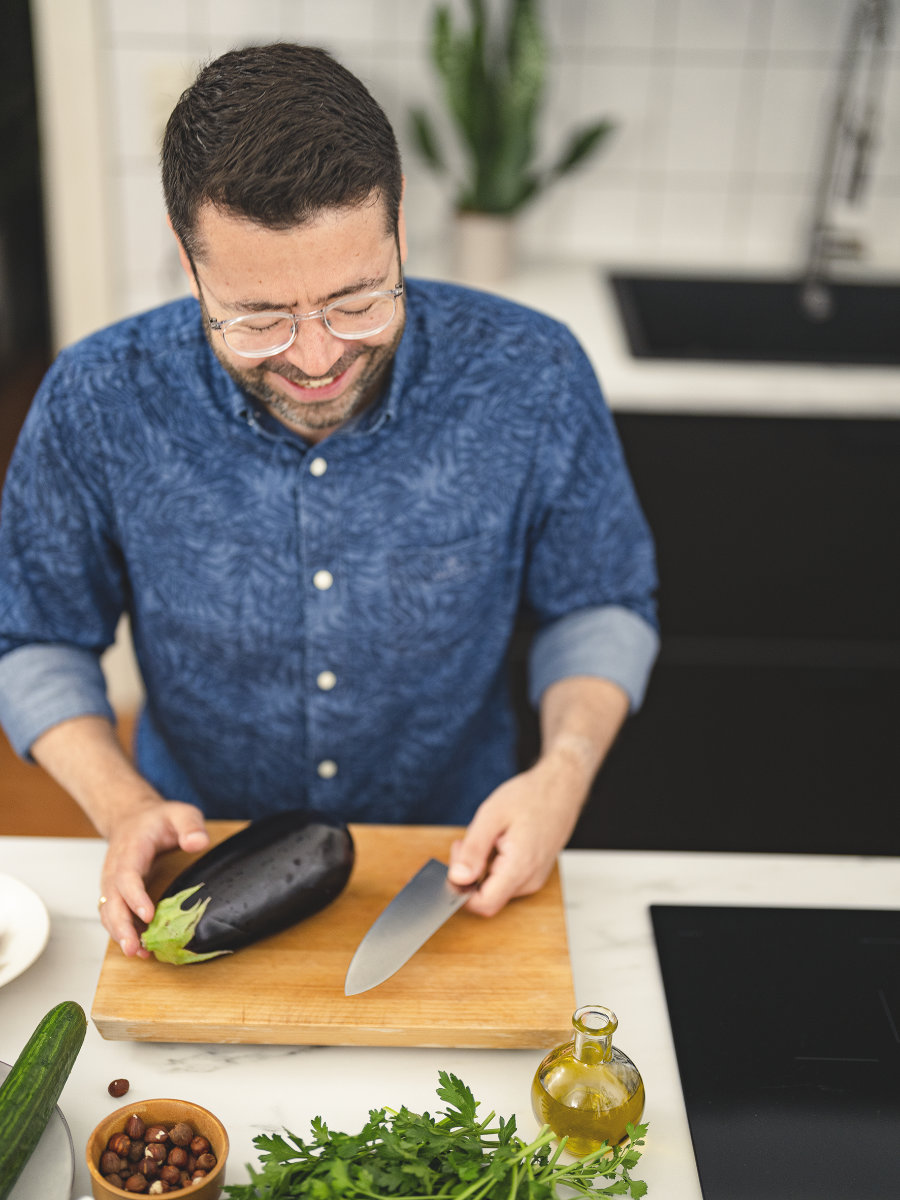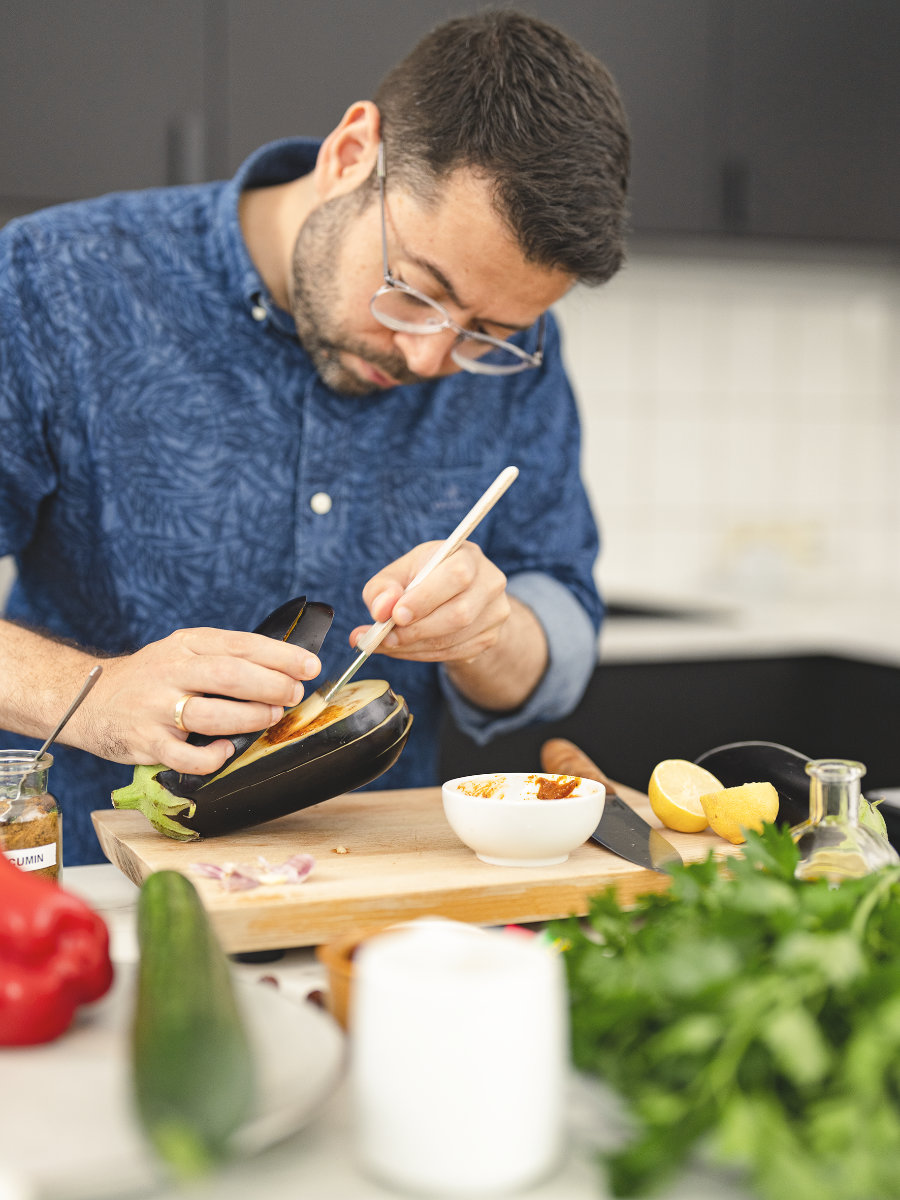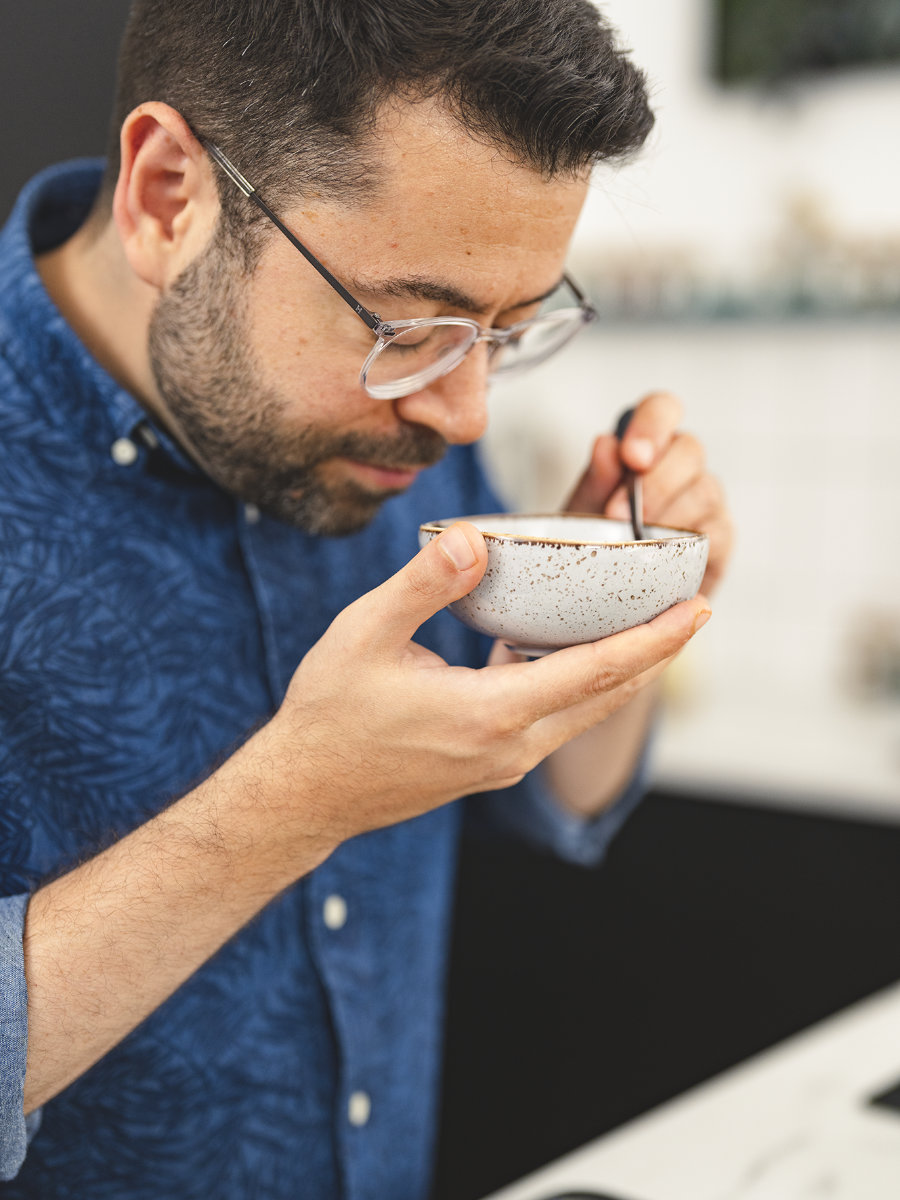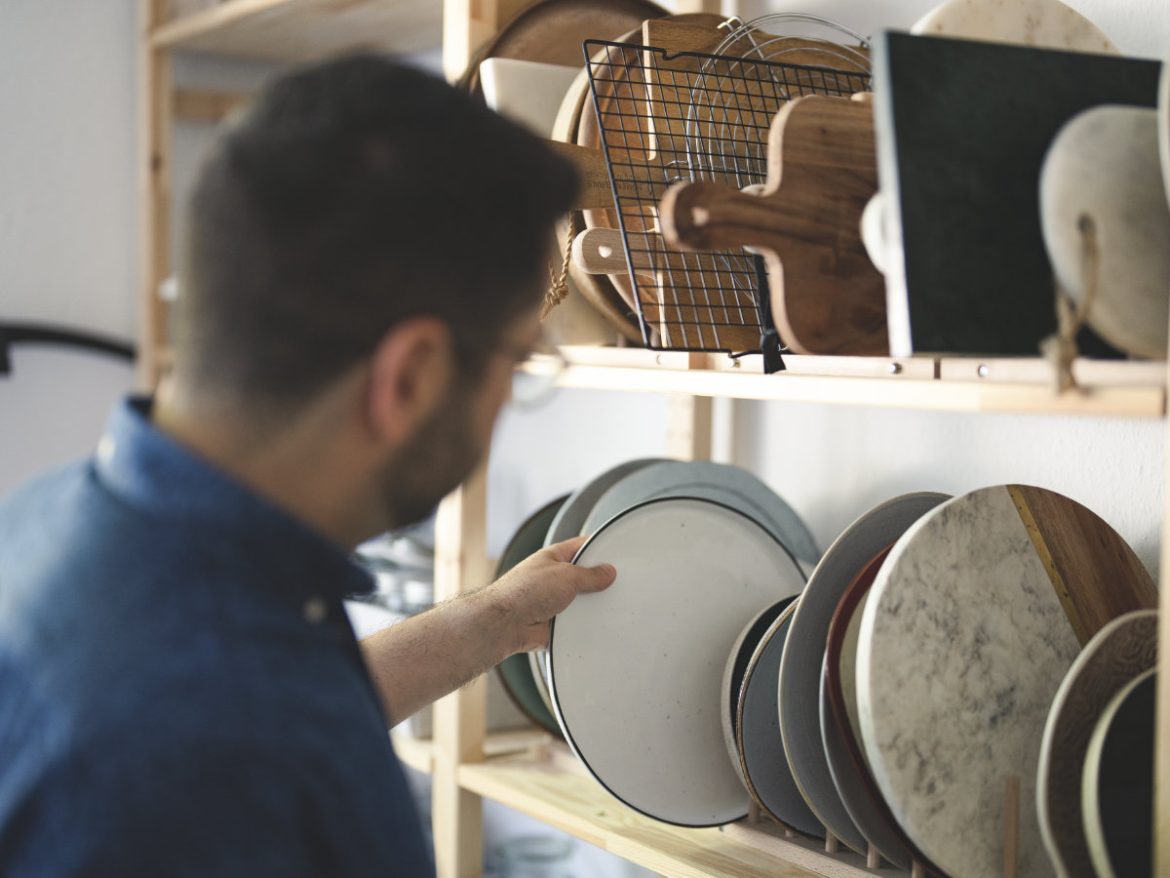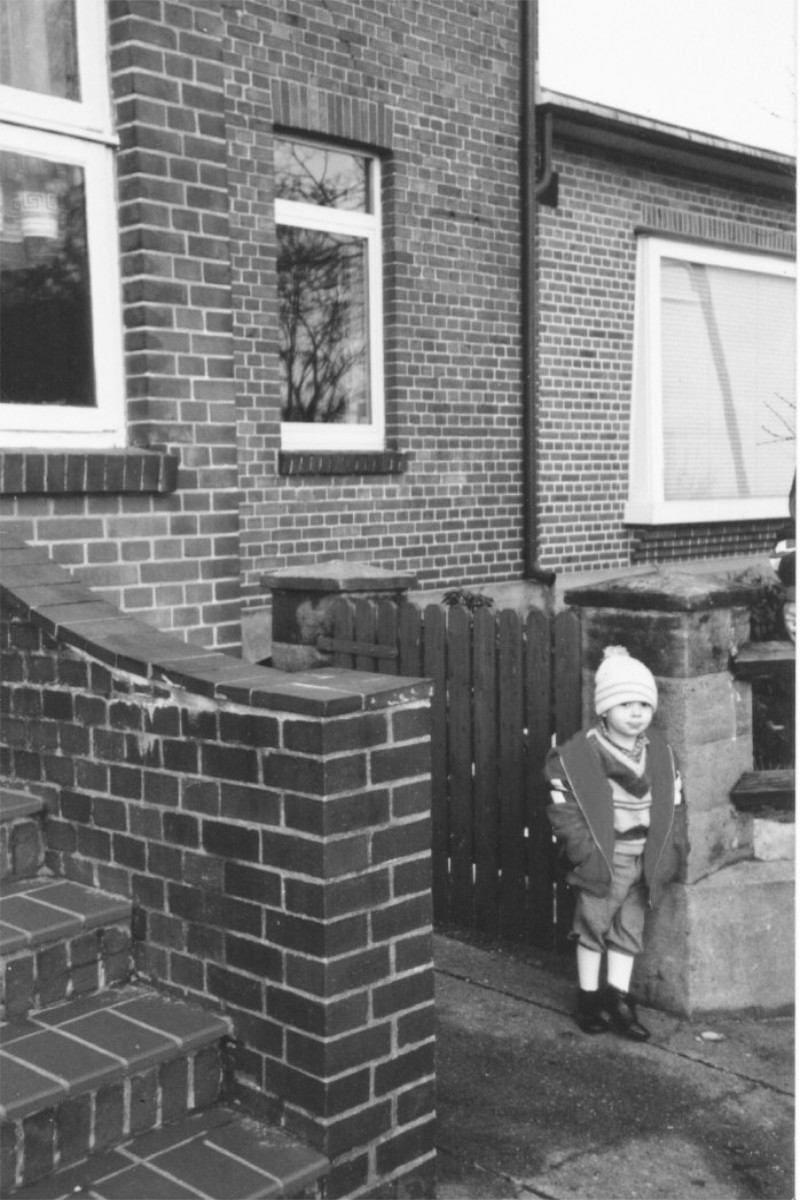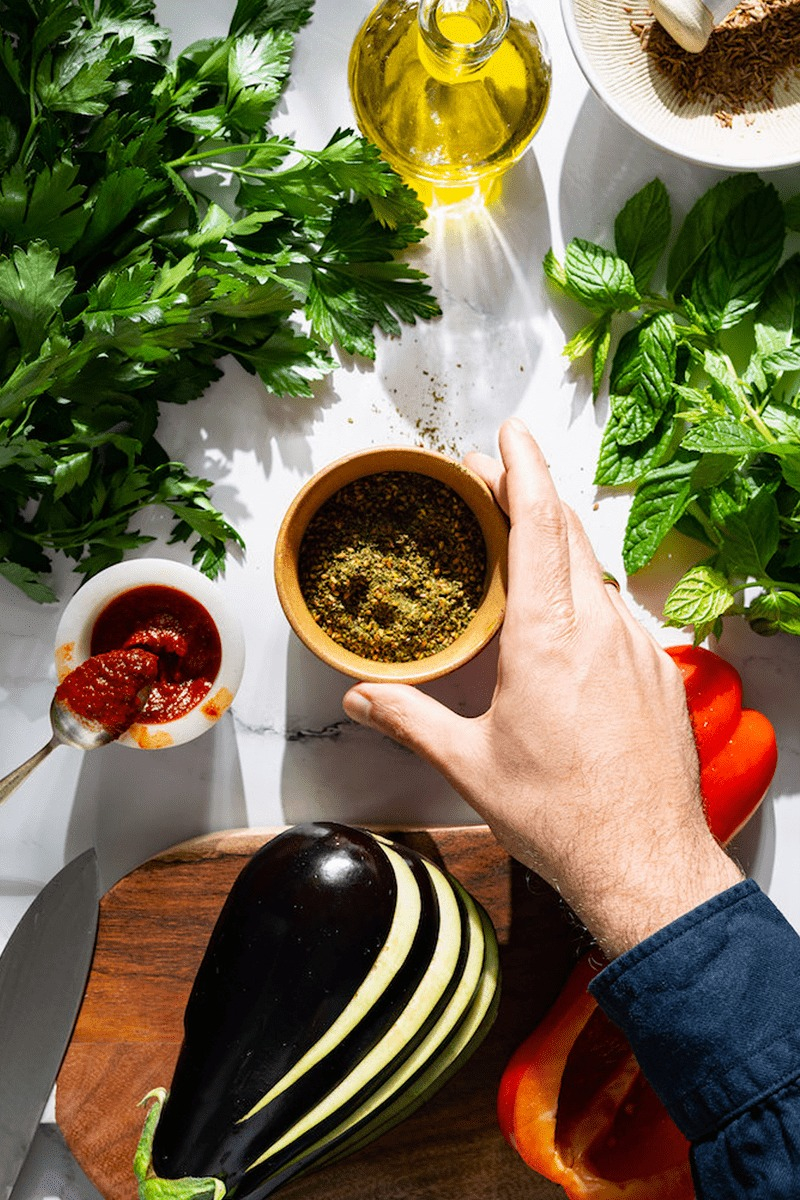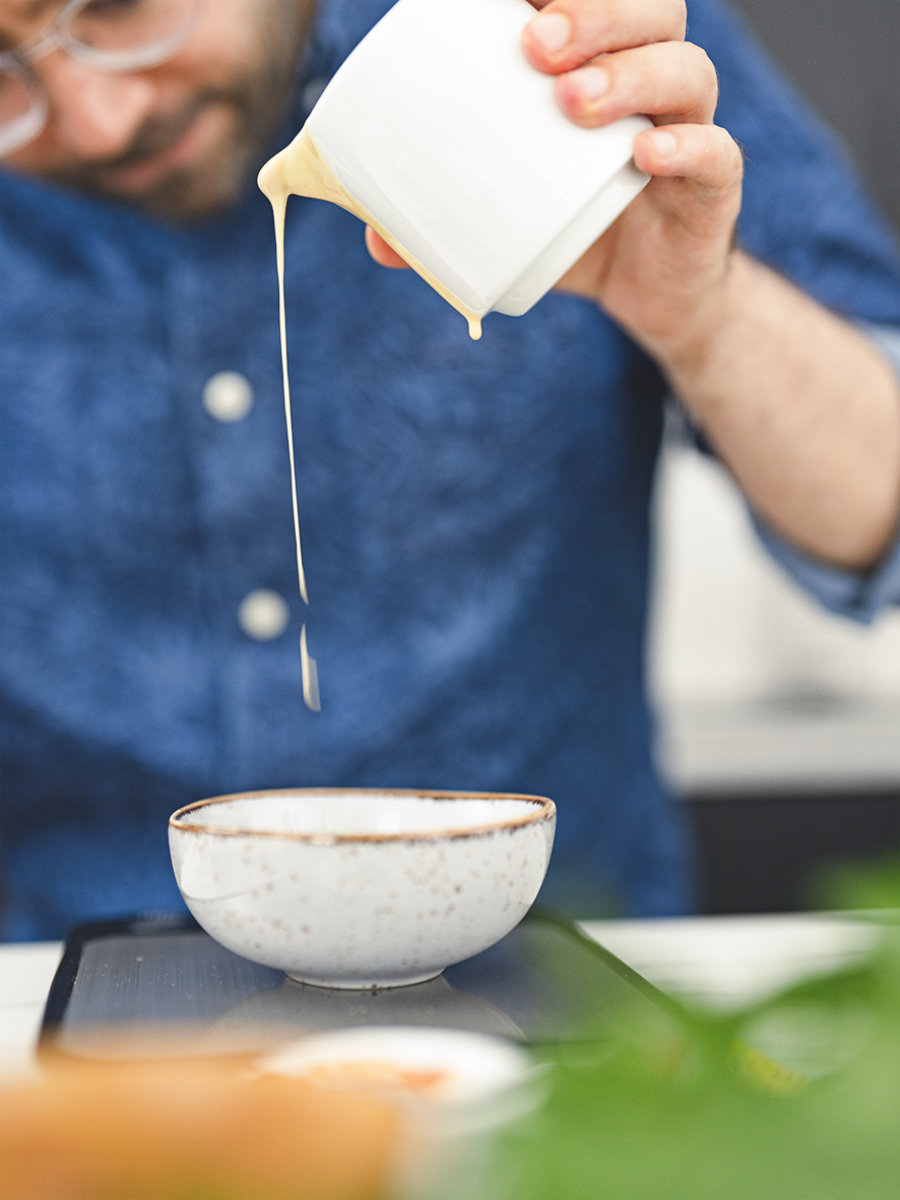Auf dem Blog Bistro Badia kocht Rafik Halabi Rezepte aus dem Libanon und der Levante und verbindet sie mit Erinnerungen und Geschichten seiner eigenen Familie zu einer Explosion aus Aromen und Farben. Überzeugt Euch selbst – Rafik verrät uns sein Rezept für Gebackene Harissa-Aubergine auf Joghurt mit Honig-Paprika und Haselnuss-Tahini-Creme. Yummie!
>>Please scroll down for English version!<<
Cremiger Hummus, die erfrischende Säure von Taboulé und der Geschmack von Tahini, Minze und Granatäpfeln – kaum eine Küche ist so farbenfroh, aromatisch und kommunikativ wie die der Levante. Wir von THE DORF sind schon seit erster Stunde große Fans der nahöstlichen Würze und wünschten uns für Düsseldorf noch ein paar entsprechende Gastro-Adressen. Doch es keimt Hoffnung auf. Dank Bistro Badia.
Auf dem charmanten Foodblog von Rafik Halabi dreht sich alles um die Speisen der Levante, die Speisen seiner Familie. „Seitdem ich als Kind halbwegs das aufrechte Stehen beherrschte, trieb ich mich am liebsten bei meiner Mutter in der Küche herum“, sagt der 41-jährige Oberbilker. „Einerseits tat ich das, weil es dort immer so unglaublich lecker duftete, andererseits weil es mich unglaublich faszinierte, mit wie viel Hingabe meine Mutter aus einigen wenigen Zutaten die leckersten Mahlzeiten zauberte.“ Als Hommage an seine Mama trägt Rafiks Blog ihren schönen Namen: Bistro Badia.
Fast alle Rezepte hat Rafik von seiner Mutter Badia gelernt – und sie hat fast alle von ihrer Mutter oder ihren Geschwistern gelernt. Geboren in Beirut, aufgewachsen in der Lüneburger Heide, hat Rafik ihr stundenlang beim Kochen zugeschaut. Seine größte Faszination galt dem Fladenbrot. Wie der Teig erst mühsam geknetet wurde und sich dann unter Hitze magischerweise zu einem knusprigen Ballon aufblähte – Rafik saß staunend vor dem Backofenfenster und rieb sich verwundert die Augen.
30 Jahre später steht er in seinem kleinem stylischen Kochstudio mitten in Oberbilk. Hier reihen sich auf dem grünen Designerregal dutzende Gewürzgläser, hier knetet die schicke rote Kitchen Aid Maschine unaufhörlich Hefeteig. Seit 2016 kocht und bloggt Rafik Rezepte, die fast so gut wie bei Mama Badia schmecken. „Nur das Fünkchen ihrer Liebe fehlt“, sagt Rafik lachend.
Das Schöne an Bistro Badia: Man fühlt sich fast wie zu Hause bei Familie Halabi. Neben den leckeren traditionellen libanesischen Rezepten nimmt sich Rafik viel Raum für sehr persönliche Erinnerungen und Geschichten. Rund 200 Rezepte umfasst Bistro Badia – eins der beliebtesten ist Fasolia, ein traditioneller Eintopf aus weißen Bohnen in einer herzhaften Tomatensauce mit Koriander und reichlich Knoblauch. „Es ist nicht fancy, aber ein Seelenwärmer“, schwärmt Rafik. Das Rezept ”duftet und schmeckt für mich absolut nach Kindheit und Ruhe“ und treibt ihm allein schon bei dem Gedanken daran Tränen in die Augen. Emotionen wie diese machen Bistro Badia zu einem ganz besonderen Juwel unter den Foodblogs.
Zu den All Time Favorites unter den Blog-Rezepten gehören Klassiker wie Hummus, die Auberginencreme Baba Ghanoush und Kafta, levantinische Köfte. Rafik schaut aber auch gerne über den kulinarischen Tellerrand und verbindet die Küche der Levante mit anderen Einflüssen zu raffinierten Fusion-Gerichten. So wie sich Familienrezepte von Generation zu Generation verändert, interpretiert er aus Spaß am Kochen Tradition immer wieder neu. Die besten Ideen für neue Rezepte kommen Rafik vor dem Einschlafen: „Ich sehe und schmecke die Gerichte dann schon in meinem Kopf!“
Das Tolle an der Levante Küche: Obwohl sie aus dem Nahen Osten stammt, kann sie auch bei uns aus saisonalen und regionalen Zutaten und viel frischem Gemüse zubereitet werden, wie etwas Blumenkohl, Tomaten, Gurken und Auberginen, die es ja an jeder Ecke gibt. Durch Säure von frischen Zitronen, feine Röstaromen, Olivenöl, Nüssen und natürlich frischen Kräutern bekommt sie dann ihren ganz besonderen Charakter. Und natürlich auch durch Gewürze wie Zimt, das als special Zutat Salate und Tomatensaucen gleichermaßen pimpt.
„Die Schönheit der levantinischen Küche liegt im Simplen. Aus wenigen Zutaten kann man ein ganzes Geschmacksspektakel kreieren“, beschreibt es Rafik.. Etwa, wenn Auberginen mit genug Hitze und Feuer ein einzigartiges rauchiges Aroma entfalten. Und mit nur etwas Tahini, Zitrone, Salz und Pfeffer zum einzigartigen Genuss verschmelzen. Zwei Gewürze verleihen dabei fast jedem Gericht einen Hauch Levante: „Sumach und Zatar, der Duft meiner Kindheit“, schwärmt Rafik und erinnert sich, wie seine Mutter das Thymiankraut immer selbst getrocknet hat und anschließend das ganze Haus tagelang danach roch. Viele seine Kindheitserinnerungen sind mit Essen verbunden, auch die der libanesischen Gastfreundschaft.
„Als meine Eltern aus dem Libanon mit uns in das kleine Dorf in der Lüneburger Heide gezogen sind, haben sie zuallererst alle Nachbarn zum Essen eingeladen“, erinnert sich Rafik. Vor allem Mezze, das Prinzip des Teilens vieler Vorspeisen, ist ein kollektives und sehr sinnliches Esserlebnis. Besonders lecker mit Fuhl, einer Paste aus zermatschten Favabohnen und Kichererbsen, die mit frischen Tomaten, Petersilie und Minze garniert und von allen mit Fladenbrot aus der Hand (traditionell eigentlich zum Frühstück) gegessen wird. Rafik absolutes Lieblingsgericht ist aber Manakisch, eine Art levantinische Pizza, die traditionell mit Olivenöl, Zwiebeln und Zatar und Käse belegt wird – eines der Nationalgerichte im Libanon.
Dass Bistro Badia für seine Leser*innen mehr ist, als nur eine Rezepte-Sammlung, merkt Rafik Halabi an den vielen Kommentaren und Mails, aus denen sogar Brieffreundschaften entstanden sind. „Wenn jemand schreibt, mein Rezept erinnert ihn an die Küche seiner Mama oder Oma, ist das das allergrößte Kompliment für mich“, sagt der Blogger. Kochen muss nicht nur Emotionen oder Erinnerungen wecken, sondern vor allem auch einfach sein und Spaß machen. Den einen oder anderen Hack hat Rafik dafür in petto: Dass man den Frischkäse Labneh selbst zubereitet, in dem man Yoghurt in einen Kaffeefilter hängt. Oder dass man Kichererbsen in mit Backpulver versetztem Wasser aufweicht und kocht, um sie besonders weich zu machen.
Momentan experimentiert Rafik viel mit eingelegtem Gemüse und perfektioniert die Grundlagen der levantinischen Küche – etwa das perfekte Fladenbrot. Gemeinsam mit seiner Assistentin Lara experimentiert, wiegt und knetet er in seinem Oberbilker Kochstudio und vergleicht genauestens die einzelnen Komponenten wie Zutaten, Ruhezeit und Hitze. Mehl. Hefe. Wasser. Olivenöl. Zucker. Salz. Mehr bedarf es eigentlich nicht – und doch…
Bereits während seines Studiums in Osnabrück entdeckte Rafik seine eigene Leidenschaft für die levantinische Küche und bekochte begeisterte Freunde, zog der Liebe wegen nach Düsseldorf und arbeitete, neben seinem ehemaligen Job in einem Food Start-Up, seit sechs Jahren an Bistro Badia. Der Blog ist für Rafik ein Experimentierfeld, auf dem der studierte Kunstwissenschaftler seine ganze Kreativität ausleben kann. Von der Fotografie über Videographie bis zum Foodstyling hat der Enthusiast mit einem besonderen Auge für Details sich alles selbst beigebracht. Seine jüngste Leidenschaft sind Stop-Motion-Filme, die so liebevoll, charmant und detailverliebt gestaltet sind, dass man gar nicht damit aufhören kann, die hüpfenden Teigtaschen und winkenden Weinblätter anzuschauen.
Mittlerweile hat Rafik mit Storymade eine eigene Agentur und produziert für Kunden kreativen Food Content mit multisensorischem Storytelling. Und das Beste: Er arbeitet gerade an einem Kochbuch, das nächstes Jahr erscheint und dessen Inhalt noch ein Geheimnis ist. Nur so viel sei verraten: Fotos von orientalischen Bazaren, Gewürzpyramiden und nahöstlichen Oramenten sucht man darin vergeblich. Stattdessen perfekt inszenierte, raffinierte levantinische Gerichte. Und vielleicht auch das Rezept für das beste Fladenbrot der Welt.
GEBACKENE HARISSA-AUBERGINE AUF JOGHURT MIT HONIG-PAPRIKA UND HASELNUSS-TAHINI-CREME
FÜR DIE AUBERGINE
- 2 Auberginen
- 2 Knoblauchzehen
- 1 TL Harissa
- 1 TL Salz
- 1 TL Cumin
- 2 TL Zitronensaft
- 2 TL Olivenöl
- Backofen auf ca. 250 °C Ober- und Unterhitze vorheizen.
- Knoblauchzehen schälen und fein reiben oder mit Salz fein zerstoßen.
- Knoblauch mit Harissa, Salz, Cumin, Zitronensaft und Olivenöl zu einer Paste vermengen.
- Auberginen waschen und längst in ca. fingerdicke Scheiben einschneiden, aber nicht durchschneiden. Der obere Part bleibt dran. Die Aubergine lässt sich jetzt Scheibe für Scheibe aufklappen.
- Paste mit einem Pinsel gleichmäßig auf die Scheiben verstreichen.
- Auberginen in eine Auflaufform oder auf ein Backbleck geben (Schnitte seitwärts!) und für ca. 20 bis 25 Minuten im vorgeheizten Backofen backen.
FÜR DIE HONIG-PAPRIKA
- 1 rote Paprika, groß
- 50 ml Olivenöl
- 1 – 2 Knoblauchzehen
- ½ TL Harissa
- 1 EL Honig
- Salz
- Knoblauch schälen und in dünne Scheiben schneiden.
- Paprika halbieren, entkernen und in kleine Würfel schneiden.
- Olivenöl in eine Pfanne geben und auf mittlerer Stufe erhitzen. Paprika, Harissa und Knoblauch hinzugeben und für ca. 10 Minuten auf mittlerer Stufe schmoren lassen. Anschließend den Honig hinzugeben und weitere 5 Minuten schmoren. Mit Salz abschmecken und Pfanne vom Herd nehmen.
FÜR DIE HASELNUSS-TAHINI-CREME
- 20 g Haselnüsse
- 20 g Tahini
- 20 ml Wasser
- 1 TL Zitronensaft
- Prise Salz
- Haselnüsse fein hacken und in einer Pfanne kurz anrösten. Pfanne anschließend direkt vom Herd nehmen.
- Tahini, Wasser, Zitronensaft und die Hälfte der Haselnüsse miteinander vermengen, bis es cremig ist.
AUSSERDEM
- 200 g Joghurt (10%)
- 2 Handvoll Petersilie
- 4 Stängel Minze
- Kräuter hacken.
- Joghurt auf Teller verstreichen und mit gebackener Aubergine belegen.
- Alles mit Honig-Paprika und Haselnuss-Tahini-Creme sowie restlichen Haselnüssen und Kräutern toppen.
@BISTROBADIA.DE BISTROBADIA.DE
Text: Karolina Landowski
Fotos: Rafik Halabi, Lara-Morgaine Böttcher
© THE DORF 2022
English version:
In his blog Bistro Badia, Rafik Halabi cooks recipes from Lebanon and the Levant and combines them with memories and stories from his own family to create an explosion of flavours and colours. See for yourself – Rafik shares his recipe for Baked Harissa Aubergine on Yoghurt with Honey Paprika and Hazelnut Tahini Cream. Yummie!
Creamy hummus, the Crefreshing acidity of taboulé and the taste of tahini, mint and pomegranates – hardly any cuisine is as colourful, aromatic and communicative as that of the Levant. We at THE DORF have been big fans of Middle Eastern spice since the very beginning and wished for a few more corresponding gastro addresses for Düsseldorf. But there is hope. Thanks to Bistro Badia. On Rafik Halabi’s charming food blog, everything revolves around the food of the Levant, the food of his family. “Ever since I halfway mastered standing upright as a child, I loved to hang out in my mother’s kitchen,” says the 41-year-old from Oberbilk. “On the one hand,
I did that because it always smelled so incredibly delicious there, and on the other hand, because I was incredibly fascinated by how much dedication my mother put into conjuring up the most delicious meals from just a few ingredients.” As a tribute to his mum, Rafik’s blog bears her beautiful name: Bistro Badia.
Rafik learned almost all the recipes from his mother Badia – and she learned almost all of them from her mother or her siblings. Born in Beirut, raised in the Lüneburg Heath, Rafik spent hours watching her cook. His greatest fascination was with flatbread. How the dough was first laboriously kneaded and then magically puffed up under heat into a crispy balloon – Rafik sat in front of the oven window in amazement and rubbed his eyes in wonder. 30 years later, he is standing in his small, stylish cooking studio in the middle of Oberbilk. Here, dozens of spice jars line the green designer shelf, and the chic red Kitchen Aid machine kneads yeast dough incessantly. Since 2016, Rafik has been cooking and blogging recipes that taste almost as good as from Mama Badia. “Only the spark of her love is missing,” Rafik says with a laugh.
The beauty of Bistro Badia is that you almost feel at home with the Halabi family. Besides the delicious traditional Lebanese recipes, Rafik allows plenty of room for very personal memories and stories. Bistro Badia includes around 200 recipes – one of the most popular is fasolia, a traditional stew of white beans in a hearty tomato sauce with coriander and plenty of garlic. “It’s not fancy, but it’s a soul warmer,” Rafik enthuses. The recipe “absolutely smells and tastes like childhood and tranquillity to me” and brings tears to his eyes just thinking about it.
Emotions like these make Bistro Badia a very special jewel among food blogs. All-time favourites among the blog recipes include classics like hummus, the aubergine cream baba ghanoush and kafta, Levantine köfte. But Rafik also likes to think outside the culinary box, combining Levantine cuisine with other influences to create sophisticated fusion dishes. Just as family recipes change from generation to generation, he constantly reinterprets tradition for the fun of cooking. The best ideas for new recipes come to Rafik before he falls asleep: “I can already see and taste the dishes in my head!”
The great thing about Levantine cuisine is that although it originates from the Middle East, it can also be prepared here using seasonal and regional ingredients and lots of fresh vegetables, such as cauliflower, tomatoes, cucumbers and aubergines, which are available on every corner. The acidity of fresh lemons, fine roasted flavours, olive oil, nuts and of course fresh herbs give it its very special character. And, of course, spices like cinnamon, a special ingredient that pimps salads and tomato sauces alike. “The beauty of Levantine cuisine lies in its simplicity. You can create a whole taste spectacle from just a few ingredients,” Rafik explains. For example, when aubergines develop a unique smoky aroma with enough heat and fire. And with just a little tahini, lemon, salt and pepper, they melt into a unique pleasure.
Two spices add a touch of Levant to almost every dish: “Sumac and zatar, the scent of my childhood,” Rafik enthuses, remembering how his mother used to dry the thyme herb herself and afterwards the whole house smelled of it for days. Many of his childhood memories are linked to food, including that of Lebanese hospitality. “When my parents moved with us from Lebanon to the small village in the Lüneburg Heath, the first thing they did was invite all the neighbours over for dinner,” Rafik recalls.
Especially mezze, the principle of sharing many starters, is a collective and very sensual dining experience. It is especially delicious with fuhl, a paste of mashed fava beans and chickpeas garnished with fresh tomatoes, parsley and mint and eaten by all with pita bread from the hand (traditionally actually for breakfast). Rafik’s absolute favourite dish, however, is manakish, a kind of Levantine pizza traditionally topped with olive oil, onions and zatar and cheese – one of the national dishes in Lebanon.
Rafik Halabi notices that Bistro Badia is more than just a collection of recipes for its readers from the many comments and emails, which have even led to pen-pals. “When someone writes that my recipe reminds them of their mum’s or grandma’s cooking, that is the greatest compliment for me,” says the blogger. Cooking must not only evoke emotions or memories, but above all be simple and fun. Rafik has a hack or two up his sleeve for this: that you can make your own Labneh cream cheese by hanging yoghurt in a coffee filter. Or that you soak chickpeas in water mixed with baking powder and cook them to make them extra soft.
At the moment, Rafik is experimenting a lot with pickled vegetables and perfecting the basics of Levantine cuisine, such as the perfect flatbread. Together with his assistant Lara, he experiments, weighs and kneads in his Oberbilk cooking studio, carefully comparing individual components such as ingredients, resting time and heat. Flour. Yeast. Water. Olive oil. Sugar. Salt. That’s all it really takes – and yet…
Rafik discovered his own passion for Levantine cuisine while studying in Osnabrück and cooked for enthusiastic friends, moved to Düsseldorf for love’s sake and, alongside his former job in a food start-up, has been working on Bistro Badia for six years. For Rafik, the blog is a field of experimentation where the art graduate can live out all his creativity. From photography to videography to food styling, the enthusiast with a special eye for detail has taught himself everything. His latest passion are stop-motion films, which are so charmingly and lovingly detailed that you can’t stop looking at the bouncing dumplings and waving vine leaves.
Rafik now has his own agency, Storymade, and produces creative food content with multi-sensory storytelling for clients. And best of all, he is currently working on a cookbook that will be published next year and whose contents are still a secret. Only this much can be revealed: You won’t find photos of oriental bazaars, spice pyramids and Middle Eastern orments in it. Instead, perfectly staged, refined Levantine dishes. And perhaps also the recipe for the best flatbread in the world.
BAKED HARISSA AUBERGINE ON YOGHURT WITH HONEY PEPPERS AND HAZELNUT TAHINI CREAM
FOR THE AUBERGINE
- 2 aubergines
- 2 cloves of garlic
- 1 tsp harissa
- 1 tsp salt
- 1 tsp cumin
- 2 tsp lemon juice
- 2 tsp olive oil
- Preheat the oven to approx. 250 °C top and bottom heat.
- Peel the garlic cloves and grate finely or crush finely with salt.
- Mix the garlic with harissa, salt, cumin, lemon juice and olive oil to make a paste.
- Wash the aubergines and cut them lengthways into slices about the thickness of a finger, but do not cut through. Leave the top part on. The aubergine can now be opened slice by slice.
- Spread the paste evenly over the slices with a brush.
- Place the aubergines in a baking dish or on a baking tray (cuts side-ways!) and bake in the preheated oven for about 20 to 25 minutes.
FOR THE HONEY PEPPERS
- 1 red pepper, large
- 50 ml olive oil
- 1 – 2 cloves of garlic
- 1⁄2 tsp harissa
- 1 tbsp honey salt
- Peel the garlic and cut into thin slices.
- Halve the peppers, remove the seeds and cut into small cubes.
- Put olive oil in a pan and heat over medium heat. Add the peppers, harissa and garlic and braise on medium heat for about 10 minutes. Then add the honey and braise for another 5 minutes. Season with salt and remove the pan from the heat.
FOR THE HAZELNUT TAHINI CREAM
- 20 g hazelnuts
- 20 g tahini
- 20 ml water
- 1 tsp lemon juice
- pinch of salt
- Chop the hazelnuts finely and roast them briefly in a pan. Remove the pan from the heat.
- Mix the tahini, water, lemon juice and half the hazelnuts together until creamy.
FURTHER
- 200 g yoghurt (10%)
- 2 handfuls of parsley
- 4 mint sprigs
- Chop the herbs.
- Spread the yoghurt on plates and top with baked aubergine.
- Top with honey pepper and hazelnut tahini cream and remaining hazelnuts and herbs. Bon Appetit!
@BISTROBADIA.DE BISTROBADIA.DE
THE DORF • THE MAG is part of the #urbanana project by Tourismus NRW






